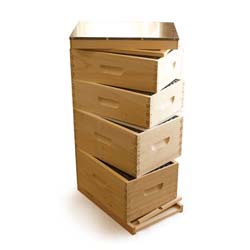If you don’t have time to extract honey when you pull the frames, you can store the frames until you have the time to extract. You can store frames in weatherproof containers until you’re able to get to them. It’s worth noting though – honey extraction should preferably be made the same day as harvest. This way, the honey is still warm in the frames making for an easier extraction.
Water content of honey should always be checked as bees can cap very wet honey (over 18.5 %) when the weather is humid. If your honey is too wet, you can use fans to help remove moisture content.
Once the honey has been filtered, allow the honey to sit for 24 to 48 hours. This allows air bubbles to rise to the surface, letting you skim them off before bottling. When letting the honey sit, let it sit somewhere inside where insects/pests can’t get to it. You don’t want to ruin all your extraction work by letting it get taken over by ants!
When bottling honey, you have the option to heat or pasteurize honey. This is mostly done by commercial beekeepers to keep their honey uniform and to filter out any minor impurities, making for a more consistent flavoring. The pasteurization process involves heating the honey to specific temperature and then rapidly cooling it.
To make bottling easier, consider warming the honey or working in a warm space. The heat will help the honey flow more easily. For a consistent pour, you can use a scale to help ensure consistent weight between bottles.
The size or shape of the container does not matter; any food grade container will work. When bottling, prepare your bottles ahead of time. Preparing bottles ahead of time may include putting labels on. For ease of extraction, it also means having the lids off, the bottles ready to receive honey. Once the honey starts flowing, it’ll be easier to have all of your supplies close by, loosen the screw on the honey gate open to allow the honey to flow out, reaching whatever capacity you are aiming for. Once it gets full enough, tighten the screw again to change out bottles.
Once finished bottling your honey, wipe the bottles down with a wet rag to wipe down any honey that may have gotten on the sides. From here you can place your labels on the containers. Store your honey in a cool, dark place to prevent crystallization.
If you plan to sell your bottled honey, be sure to check local ordinances for labelling instructions.
